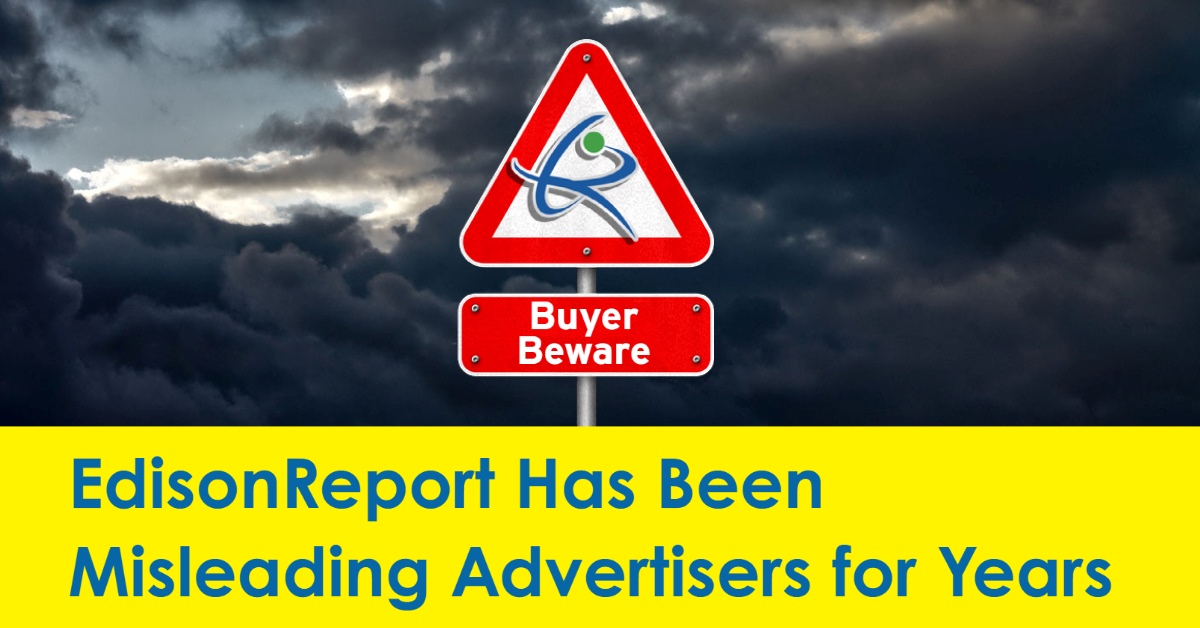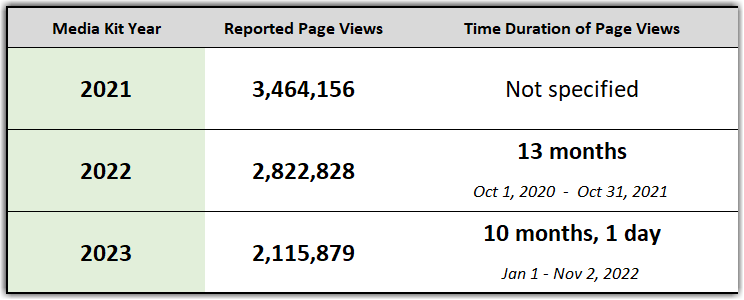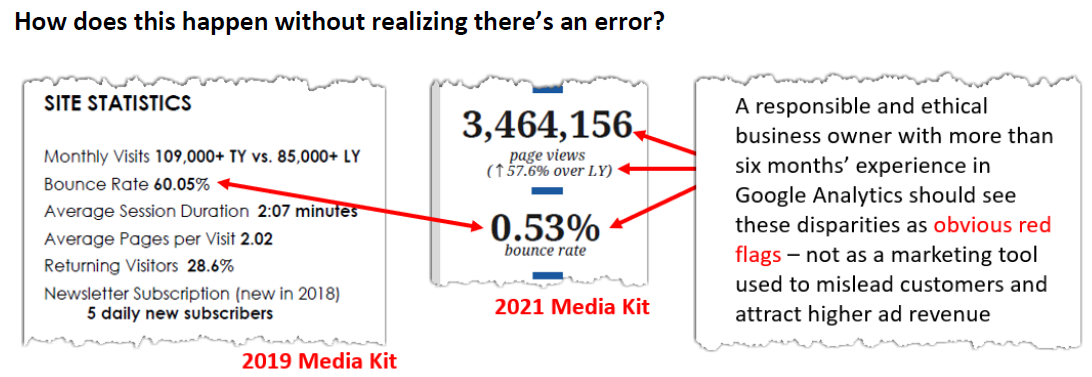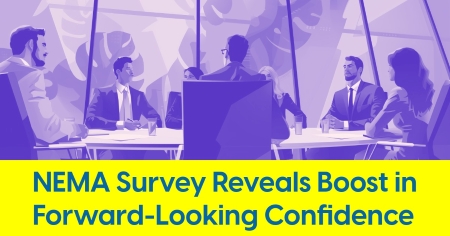March 15, 2023
EdisonReport has been Misleading Advertisers for Years

Since 2019, EdisonReport has been wooing advertisers with inflated website traffic statistics
EdisonReport yesterday published a statement admitting to a years-long practice of publishing inaccurate website data that was made available to advertisers and advertising prospects. EdisonReport Editor and Publisher, Randy Reid, stated that the Google Analytics data for the website has been inaccurate since July 2019 – leading to false reports of the website’s traffic. Those misstatements helped EdisonReport portray itself to advertisers as a much more heavily-trafficked website than it is. EdisonReport claims to have recently "removed the faulty code" on March 10, 2023.
Cashing in on Triple-Counted Page Views
-
1 actual page view = 3.
-
2 actual page views = 6.
-
3 actual page views = 9…and so on.
When an advertiser spends precious marketing dollars on digital ads, page views matter. More pageviews lead to more ad impressions. For a publisher, 3,000,000 page views will attract significantly more ad revenue than 1,000,000 page views will. With three tracking codes on its webpages, EdisonReport has seemingly been triple-counting page views and passing those inflated stats along to unsuspecting advertisers.
“We reported incorrect page views, page views per session and bounce rates in our media kit from July of 2019 until March 2, 2023.”
— Randy Reid, Editor and Publisher, EdisonReport
The most reckless example of EdisonReport’s false advertising is its years-long practice of publishing egregiously inflated page view numbers in its Media Kit. For any publication, the Media Kit is the most important, and oftentimes, the only piece of marketing collateral that a publication shares with advertisers.
In 2022, inside.lighting noticed that on hundreds of webpages – and likely on all webpages – EdisonReport was seemingly TRIPLE COUNTING page views by inserting THREE Google Analytics tracking codes into each and every EdisonReport webpage.
-
Tracking code #1 was the typical Google Analytics tracking code
-
Tracking code #2 was a plugin from MonsterAnalytics
-
Tracking code #3 was a plugin from ExactMetrics
The tracking codes sourced from MonsterAnalytics and ExactMetrics are accompanied by clear instructions and bold warnings from each publisher about the critical importance of not installing multiple tracking codes – warnings that EdisonReport seemingly overlooked and monetized.

Despite reporting inflated page views each year, EdisonReport shows a declining trend in web traffic.
The flashing police siren warning was ignored since 2019
One of the inaccurate metrics captured and published by EdisonReport was something called “Bounce Rate” which is an indication of how many website visitors “bounce” after viewing just one page – the lower the number, the better. Most sites have a Bounce Rate between 40% and 70%. A number below 30% is almost unheard of and a likely indication that something is broken with the data collection.
Very few advertisers likely give a rip about Bounce Rate, but the impossible Bounce Rate number published in EdisonReport Media Kits for years should have been the flashing police siren to EdisonReport’s publisher indicating that the data was clearly erroneous. Fixing the clearly-broken bounce rate issue would have caused EdisonReport to simultaneously fix the inflated 3-for-1 page view multiplier error, too. This was a clear warning flag that should have been noticed and fixed right away, but it persisted for years.
Mathematically Possible, but Blatantly Untrue
Any marginally capable webmaster who has worked with Google Analytics for more than six months should realize that a sub-10% bounce rate is as believable as a golfer claiming he shot a 54 at Augusta National – where, after 80+ Masters tournaments, the course record is a 63. EdisonReport published ridiculously low Bounce Rates as low as 0.53% in 2021 and 1.64% in 2022. But those obvious warning signs went unchecked as EdisonReport published inflated page view stats year after year.
EdisonReport’s false advertising wasn’t limited to Media Kits as Randy Reid also boasted about the website’s falsely inflated page views in conversation. In one instance during a March 2020 Illuminating Engineering Society podcast, Reid flexed, "Normally EdisonReport gets anywhere from 5,000 to 8,000 page views per business day. On Monday we had 63,000."
"Normally EdisonReport gets anywhere from 5,000 to 8,000 page views per business day. On Monday we had 63,000."
— Randy Reid on an IES podcast in March 2020
File photo: Reid in 2020
An ongoing string of reckless behavior from EdisonReport
False advertising is one of the most serious ethical breaches any publisher or marketer could engage in. Plagiarism is also one of the most serious ethical breaches a publisher or journalist could engage in. In just the last 60 days, EdisonReport has committed three instances of those “publishing mortal sins.”
In addition to misleading advertising, other ethical breaches by EdisonReport include:
-
2023 PLAGIARISM Instance #1: On January 20, EdisonReport copied and pasted an entire article from New York Times-owned Boston.com. Earlier that day, we at inside.lighting spent 4-5 hours contacting eight stakeholders, researching and writing our version of an article on the same subject – a Massachusetts high school lighting project. Blatantly republishing another author’s copyrighted work word-for-word was a shortcut we never considered, but EdisonReport published a professionally written story in less than 5 minutes’ time.
-
2023 PLAGIARISM Instance #2: On January 26, an article published on EdisonReport, by author “Randy Reid” was entirely copied from another journalist’s copyrighted work on Law360 – a leading legal news site. Despite the author of the EdisonReport article being cited as “Randy Reid,” Reid denied having any involvement whatsoever with the article during a recent appearance on the Get a Grip on Lighting podcast. He claimed that the entire article somehow ended up published on EdisonReport unintentionally and that it was done by a new employee, not Reid, despite the “Randy Reid” byline.
-
The headlines of both plagiarized articles had a good long, run on the EdisonReport home page and then quietly disappeared from the EdisonReport website after 9 days and 20 days respectively.
-
In recent years, we have sent EdisonReport cease and desist notices for publishing inside.lighting copyrighted work.
-
In recent years, we have sent EdisonReport cease and desist notice for demanding “EXCLUSIVE. MUST CREDIT EDISONREPORT” for news that inside.lighting published days earlier.
Unintentional “mistakes” or ethical breaches?
In mid-February, Randy Reid appeared on the Get a Grip on Lighting podcast and was asked by hosts Michael Colligan and Greg Erich about the recently plagiarized articles. A jovial Reid mostly laughed off the plagiarism accusations and then, in a dramatic way, compared the EdisonReport's plagiarism “mistakes” to the podcast hosts making a typo a year ago – an indication that Reid may not fully comprehend the seriousness of plagiarism. Plagiarism causes middle schoolers to fail papers. It causes high schoolers to flunk courses and get suspended. It causes college students to get expelled. And it causes journalists to get fired – unless, apparently, the journalists work for EdisonReport.
During the Get a Grip podcast appearance, Reid did his best to play the victim and wonder why certain people are “going after” him. EdisonReport is not the victim. EdisonReport is the perpetrator who has been violating other publications' copyrights and misleading its customers through false advertising. At what point do these repeated “mistakes” (which Reid consistently blames on others) simply demonstrate a lack of sound process and ethics?
Fair play and a level playing field
At inside.lighting we seek to compete with all electrical industry publications on a level playing field. When we invest 4 to 5 hours in an article, we expect our competitors to publish their story without taking unethical shortcuts by copying and publishing the copyrighted work of other journalists. When a potential advertiser compares our web traffic to a competitor’s, we simply want to be compared to real statistics, not misleadingly inflated, triple-juiced numbers.
Earlier this year, inside.lighting contracted with two independent expert witnesses/consultants to evaluate EdisonReport’s web stats and HTML code. They found numerous irregularities that would lead to erroneous data in EdisonReport’s favor. We brought the matter to EdisonReport’s attention in February and EdisonReport finally ended the years-long practice of deceptive advertising and flawed data collection in recent days. We sought EdisonReport’s collaboration in coordinating a joint public disclosure of EdisonReport’s misleading advertising, but EdisonReport decided to issue a solo announcement – which was their prerogative.
If any lighting industry publication repeatedly acts unethically and/or unlawfully, we feel compelled to bring those actions to the public’s attention. These matters may not be the FTX meltdown or the Volkswagen Emissions scandal, but they are important and relevant to lighting people and advertisers who expect their business news sources to act ethically and lawfully.
Moving forward
As we look ahead, we hope for no more watchdog mentions of EdisonReport's unethical wrongdoing and hope that all of our reporting focus will be on the stories of the people, the organizations and the technology of our beloved lighting industry – while competing on a level playing field for the honor to bring those stories to you and all of our readers.











